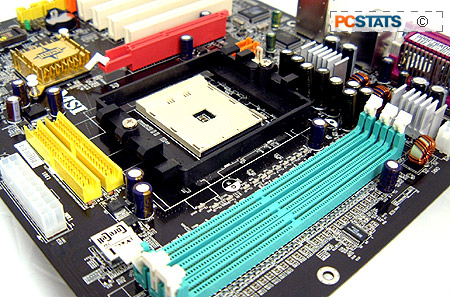One feature that we really like about nVIDIA's
nForce3-250Gb is the onboard hardware firewall. With more people jumping on
broadband, it's important to safeguard your PC against possible worm/hacker
attacks. nVIDIA has taken it upon themselves to include a hardware firewall with
their nForce2-Ultra400Gb, and nForce3-250Gb chipsets which should protect their
users from possible attacks.

To access the Firewall functions you
simply double click on the "nVIDIA Web-based Interface" icon on your desktop, or
in the programs menu and that will bring up the above window. nVIDIA has
organized their Network Access Manager into three different categories;
Ethernet, Firewall and Administration. Clicking on any of the headings or links
in the main window changes the menu to the left.

For instance, selecting the Firewall
setup gives you the following options shown above. You can use nVIDIA's defined
levels which is recommended, or configure things yourself. The hardware firewall
allows you to configure what ports are opened, closed or in stealth mode. Once
changes are made, the network interface needs to be restarted. Simply give your
PC a few minutes and you'll be all set. If you suspect any suspicious activity
you can always look things up in the firewall logs.
Please note though, the onboard hardware
firewall is not enabled by default, and you will need to access
the Network Access Manager before this feature is turned on. Once the nVIDIA
hardware firewall is turned on it should protect your computer against the most
common attacks.
Oh, Faster HyperTransport and Locks
too!
Another
area nVIDIA received a lot of flak from end
users about, with respect to the NF3-150 chipset, was the way they implemented HyperTransport. It only
ran at 600 MHz and to make things even worse, the upstream connection was
only 8-bits wide! In comparison, VIA's K8T800 HyperTransport moved data along at
the full 800 MHz bus speed, while running on a 16-bit wide bus both up,
and downstream.
In theory this would mean that
VIA's implementation of HyperTransport would be faster but in real world
benchmarks it didn't seem to make much of a difference (though
VIA did enjoy a small lead). Still, you can bet nVIDIA's competition let the
world know that the nForce3-150's HyperTransport moved slower.
 In the server world a slower HyperTransport
should be more apparent due to the higher bandwidth needs of those computers, but
we're not dealing with servers now are we?
In the server world a slower HyperTransport
should be more apparent due to the higher bandwidth needs of those computers, but
we're not dealing with servers now are we?
nVIDIA
silenced all their critics with the NF3-250, making certain that both
Hypertransport streams (up and down) are 16 bits wide, and paced at 1000MHz
instead of 800MHz. At this speed, nVIDIA has no rivals, and currently has the fastest Athlon64
platform out.
While ATI focused on creating an Intel chipset, nVIDIA
have been producing some pretty nice AMD chipsets for both K7 and K8
platforms - though they never seem to get it right the first time out.
Nvidia were first to introduce a dual channel memory architecture for the AMD platform,
and they were also first to lock the AGP/PCI bus.
While the nForce3-150 had AGP/PCI locking
capabilities, for one reason or another manufacturers never seemed to adopt
them. Things are different this time around; all nForce3-250 based motherboards
we've tested feature functioning AGP/PCI locks. This frees up enthusiasts
overclock better, and not worry about their other system components (like
videocard or Serial ATA HDD's) holding them back.
